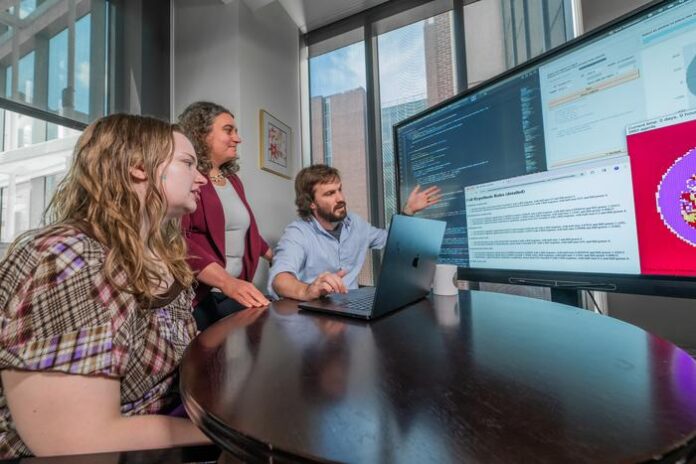Researchers at **Indiana University** and the **University of Maryland School of Medicine (UMSOM)** have unveiled a groundbreaking method to forecast cell activity in tissues over time. This innovative approach draws parallels to weather forecasting, enabling scientists to predict cellular behavior changes, which could have significant implications for cancer treatment.
The newly developed software integrates genomics technologies with computational modeling to simulate how cells communicate and evolve within tissues. This research is particularly noteworthy due to its incorporation of a plain-language “hypothesis grammar,” allowing for easier communication between biological systems and computational models. The findings were reported in the journal **Cell**, detailing virtual experiments that investigate how cancer cells interact with their environment and how the brain develops its complex layers.
Revolutionizing Cancer Treatment Through Computational Models
The collaborative effort, which involved multiple labs, merges software development with clinical research. The researchers propose that this method could eventually lead to the creation of computer programs that assist in selecting optimal treatments for cancer patients, effectively crafting a “digital twin” of the patient. According to **Daniel Bergman, PhD**, a scientist at the **Institute for Genome Sciences (IGS)** and co-lead author of the published paper, “As much as this new ‘grammar’ enables communication between biology and code, it also enables communication between scientists from different disciplines to leverage this modeling paradigm in their research.”
The study emphasizes the importance of mathematical modeling in understanding how cells interact, forming ecosystems that evolve over time. While recent advancements in single-cell and spatial multiomics technologies have allowed for the quantification of individual cell characteristics, predicting their evolution remains a challenge. The research team noted that while bioinformatics and machine learning can track changes in individual cell types, they fall short in addressing more complex dynamics across multicellular networks.
**Jeanette Johnson, PhD**, a postdoctoral fellow at IGS, highlighted the limitations of traditional biomedical research, stating, “The result is still a single snapshot in time—rather than showing how diseases, like cancer, can arise from communication between the cells.” She explained that cancer is heavily influenced by the immune system, which varies significantly among individuals, complicating predictions based on human cancer data.
Creating a Digital Laboratory for Cell Behavior
**Paul Macklin, PhD**, Professor of Intelligence Systems Engineering at Indiana University, led the development of the grammar that describes cell behavior using natural language statements. This innovation allows scientists to construct digital models of multicellular biological systems using simple English descriptors. The authors remarked, “This enables systematic integration of biological knowledge and multiomics data to generate in silico models, enabling virtual ‘thought experiments’ that test and expand our understanding of multicellular systems.”
Bergman and his colleagues utilized this grammar alongside genomic data from real patient samples to study breast and pancreatic cancer. For instance, in breast cancer research, the team modeled a scenario where the immune system fails to restrict tumor cell growth, thereby facilitating cancer spread. They also adapted their computational framework to simulate a clinical trial for pancreatic cancer immunotherapy. The model demonstrated that each virtual “patient” exhibited distinct responses to the treatment, underscoring the complexity of cellular ecosystems in precision oncology.
The research team employed advanced spatial genomics technology to investigate how non-cancerous cells, known as fibroblasts, interact with tumor cells. This approach allowed scientists to track pancreatic tumor growth and invasion dynamics from actual patient tissues.
The grammar developed in this study is open-source, promoting accessibility for researchers worldwide. Bergman stated, “By making this tool accessible to the scientific community, we are providing a path forward to standardize such models and make them generally accepted.” To illustrate its versatility, **Genevieve Stein-O’Brien, PhD**, from **Johns Hopkins School of Medicine**, applied this approach in a neuroscience context, simulating brain layer development.
In summary, the authors concluded, “The new conceptual framing (a grammar) for specifying cell behavior hypotheses introduced in this study can systemize and facilitate our thinking of how cells interact to drive tissue ecosystems.” Johnson expressed excitement, noting that these models can incorporate both laboratory and human genomic data, allowing for dynamic exploration of immune cell behavior over time.
**Elana J. Fertig, PhD**, Director of IGS, reflected on her journey from weather prediction to cancer modeling, emphasizing the potential of this research to create virtual laboratories for testing hypotheses. Fertig described the study as “a tapestry of team science,” with validation of the computational models also supported by clinical collaborators at **Johns Hopkins University** and **Oregon Health Sciences University**.
**Mark T. Gladwin, MD**, Vice President for Medical Affairs at the **University of Maryland**, remarked on the significance of this work, stating, “With this work from IGS, we have a new framework for biological research since researchers can now create computerized simulations of their bench experiments and clinical trials and even start predicting the effects of therapies on patients.” He highlighted the importance of future work to extend this computational modeling of cancer beyond the lab and into clinical practice.
